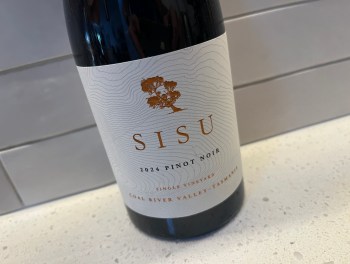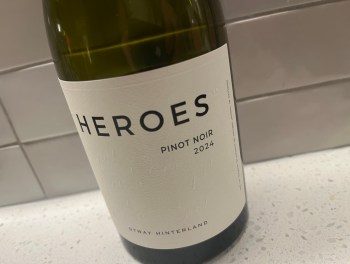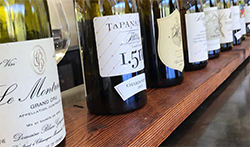I’m finally getting back into some sort of normal programming this week, or whatever that means when you’re a new parent. The little one is sleeping, but the days now seem to go even faster than normal…
I’ll be opening some more wines over the next few days, but in the meanwhile here’s a flashback from the public tasting of the Sydney International Wine Competition 2019 held several weeks ago.
The USP of this show is that the top wines are served with food. As the results booklet details, this is a bid to ‘help consumers make more pleasing wine choices for their dining table’ by rewarding ‘food-friendliness’. Further, judges are instructed to also concentrate on ‘style’ rather than just form.
And the winning wines are different than your usual show as a result.
Consistently, the trend in trophy winners and the Top 100 (a list of the best 100 wines from the show) is towards more textural and gentle than the wine awards norm.
But, intriguingly, there’s also evidence that this trend goes too far, with wines that are sound, fresh, easy, pleasurable wines of simple affability but not much else. A question of picking for understatement and ending up with not much – particularly in the whites.
Food friendly? Maybe. But otherwise just a little light on? You be the judge.
The one notable exception was the Pinot Noir bracket. One line of great wines that stuck out as almost an anomaly, on a next-level quality plane (with several bloody delicious Central Otago Pinots).
Sadly I didn’t get around to all the eclectic wines in this tasting, and you can see my hurried notes get more hurried down the page…
Words below are as written on the day. Extra context (and matching dishes) in italics. I got all caught up in the exciting Pinot and missed so much red wine at the end.
Category 1 Sparkling Wines
Originally judged with potato and apple hashbrown with saffron. Champagne was the winner in most instances here.
Champagne Collet Blanc de Blancs 1er cru NV
Trophy winner.
Pretty classic NV. Some leesy development, though the acid is a bit tinny – a little sweet and sour. Wouldn’t have been my choice for trophy. But fair enough. Classical lines too. Circa. 17.5/20, 91/100.
Jansz Late Disgorged 2010
Gold medal winner. I’ve had better bottles of this.
Late disgorged and dominant autolysis – really cheesy lees and then something of a disconnect with the acidity. Some good leesy weight and complexity, even if it’s a bit sharp edged. Satisfying enough. 17/20, 90/100.
Category 2 Aromatic Wines
Originally judged with Eggplant + miso and eggplant. Quite a mixed bag of styles, with aged wines dominating.
Patrick of Coonawarra Aged Riesling 2012
Trophy winner. Pleasurable all the way.
Honeyed toast. You could easily pick this as Clare with the dash of Bickfords in there. It’s just a nice aged Riesling. Acidity looks well integrated too. Enjoyable if a just a teensy bit broad through the finish. 17.7/20, 92/100.
Paulett Wines Aged Riesling 2013
Blue gold medal winner. Come back in a few years.
In something of a hole, lime toast forward and with a sour edge. There’s some classic lime juice at the core, but it feels in a bit of a phase. The subtle power below the surface pushes it along nicely. 17/20, 90/100.
Category 3 Sauvignon Blanc wines
Originally judged with asparagus and mushroom risotto. Marlborough Sauvignon Blanc took out all the top spots.
Toi Toi Reserve Sauvignon Blanc 2018
Trophy winner. Goes for less than $20 in Australia and well worth it.
Classic nose – gooseberry and passionfruit thiols aplenty. Sweaty passionfruit palate with a slightly raw finish. Made to win trophies with that nose. Lots of character but a divisive wine – perhaps too overt. But I admire the intensity. Will please classic Sauv drinkers. 17.5/20, 91/100.
Mission Estate Marlborough Sauv 2018
Blue gold medal winner. I only picked this up as I thought it might be Hawke’s Bay Sauv.
Capsicum. Green edges with grass aplenty and grating chunky acidity. Hard going even though intensity plus. 16/20, 87/100
Giesen Small Batch Sauvignon Blanc 2016
Gold medal winner. Very drinkable.
A pitch at Sancerre with less thiols and more textural, sulphur bound elements. A more pleasing weighty experience, even though it looks a little flat. Would be a good ‘drinking’ Sauv. I’d go a glass or two. 17.5/20, 91/100.
Category 4 Rosé wines
Originally judged with beetroot, goats cheese and roasted hazelnuts. A middling bracket.
Waipara Hills Pinot Noir Rosè 2018
Trophy winner. Value drinking but I wanted more.
Very pale. Just a little too much sweetness for mine – soft red lolly flavour. Commercial and simply refreshing, it’s a friendly wine, but that’s it. 16.5/20, 88/100.
Category 5 Lighter bodied white wines
Originally judged with snapper, zucchini and dill. All sort of wines in this bracket…
Berton Vineyards Aranel 2018
Trophy winner. Contains 2% Fiano. Apparently the judges liked the texture and thought it was interesting. Not me.
Riverina Aranel. Water clear. There’s a vague hint of waxed pear. But little else – impossible to pick the variety, with little flavour and sharp acidity. It could be early picked <insert any neutral white grape here>. Inexpensive white wine, not much else. 15/20, 83/100.
Bird in Hand Pinot Grigio 2018
Blue gold medal winner. Comes in a huge bottle that looks like it should contain expensive mineral water.
Generic Pinot Grigio that has some varietal flavour on a simple palate. Pleasant, and drinkable but a crazy bottle for a fresh, light white. 16/20, 87/100.
Yealands Estate Single Vineyard P.G.R 2018
Top 100 winner.
Marlborough Pinot Gris/Ries/Gewurz. Surprised to see how subdued this was. A light whiff of musky Gewurz and then a simple fresh palate. Simple and fresh enough but unexciting. 16.5/20, 88/100.
Category 5 Medium bodied white wines
Originally judged with corn puree, prawn and tomato. A step up.
Peter Lehmann Margaret Semillon 2012
Trophy winner.
A much more subtle Margaret and in good form. There’s a biscuity, marzipan lemon nose, the palate has some obvious age to flesh out the bones. This is easily the most approachable Margaret in some time. Is the acidity a bit drying? Nice, quite chunky aged Barossa Semillon. 17.7/20, 92/100.
La Prova Fiano 2018
Top 100 winner. Classy wine again.
Subtle, but clearly varietal. The texture is sound too. Someone has been to Italy! There’s that Fiano grip too. I like the late, vaguely honeyed richness. Another nice wine. 17.7/20, 92/100.
Category 7 Fuller bodied white wines
Originally judged with duck breast, pumpkin ‘valute’, green apple and granola. Solid bracket.
De Bortoli Yarra Valley The Estate Vineyard Chardonnay 2017
Trophy winner. Tastes like it was made for a pricepoint.
Subtle, appley, fruit forward style with minimal oak influence and grapefruit acidity. Understated, but also a bit middling too – it’s a light, sub $20 wine and lacks a little stuffing. 17/20, 90/100.
Heggies Estate Chardonnay 2016
Gold medal winner.
In a better place in recent vintages. It’s now an understated Chardonnay with apple and citrus with a layer of Sao oak. I still want this to be more like the rounder Heggies style of ola. But this fresh style has some width to it. 17.5/20, 91/100.
Church Road Grand Reserve Chardonnay 2017
Top 100 winner. Interestingly I had this blind in a lineup of Chardonnay mid week and marked it at same score! Like it.
I quite like this. Some fun sulphide funk, layers of mealy oak, leesy too. It’s a full and bold style, but actually it’s quite clever and well made. Complex and clever. 18/20, 93/100.
ALDI Stores Blackstone Paddock Limited Release Margaret River Chardonnay 2017
Top 100 winner. $14.99 is very fair.
Understated and a bit light, but varietal and there’s that Margs grapefruit and oatmeal character too. I bet this is inexpensive and really quite varietal. Handy and tastes like actual Chardonnay. 17/20, 90/100.
Category 8 Pinot Noir wines
Originally judged with venison loin, shallots and mushroom. Such a consistent, high quality lineup!
Akarua Rua Pinot Noir 2017
Trophy winner and wine of show. I marginally prefer some of the other Pinots, but hey this is tasty. Sub $30 apparently too.
Bright, cherry blackberry varietal fruit. There’s that raspberry and beetroot of good Otago Pinot in a boisterous mode. No obvious oak, all fruit and really quite enjoyable. A genuinely fun and vibrant wine. 18/20, 93/100.
Gala Estate Constable Amos Pinot Noir 2017
Top 100 winner. A new name to me.
It’s a little bacony and even perhaps a bit horsey. Grip, chew, bacon bits and alcohol. Ambitious, but I’m looking for a bit more vitality, rather than just weight. 17/20, 90/100.
Alexandra Wine Company Alex Gold Pinot Noir 2017
Top 100 winner. Class and complexity.
Open and even quite floral, rhurbarb and cherry fruit blackberry nose, over a mid weight palate that is just as pretty and substantial. So evocative on the nose, the palate is both wide and deep. Excellent. I might even be underrating it. 18.5/20, 94/100.
Coal Pit Tiwha Pinot Noir 2016
Top 100 winner. Has some guts, no question.
More outré complexity here. Maybe not an easy wine – it’s a bit meaty for that. But there’s a real heartiness here, the extra bottle time giving this more earth and layers of flavour. Substantial and high quality. 18/20, 93/100.
Grasshopper Rock Pinot Noir 2016
Top 100 winner. Always a nice wine and in good form.
Lovely nose – less of the red fruit compared to the wines around it, but with more palate weight. Whispers of cranberry, and meaty edges. It’s a lovely drinking Pinot, with a palate that feels full and convincing. Yes. 18.5/20, 94/100.
Peregrine Pinot Noir 2015
Top 100 winner. Maybe better a year ago?
A little more development and maybe loses some energy. But there’s a bunchy, late tannin firmness and blackness that is quite appealing. Slow-burning structure. High quality and plump through the middle and finish. 18/20, 93/100.
Hinton Pinot Noir 2017
Top 100 winner. Very pretty wine.
Bright purple fragrance. Really fragrant purple berries. It’s maybe too much about florals and some peppery pan juice and less palate depth but so pretty and really delicious. 18/20, 93/100.
Akarua Pinot Noir 2017
Top 100 winner. Certainly in the same mode as the Rua but just a more grown up version. So good.
Great colour and a great wine. Pan juices back up this vital and red fruit flush nose. Beauty and depth of flavour. Nails the Central Otago opulence and so substantial. High quality and frankly sessionable. 18.7/20, 95/100.
Saint Clair Delta Hatters Hills Pinot Noir 2017
Top 100 winner. Classy, genuine Marlborough Pinot Noir.
Pure and pretty Marlborough Pinot (but not shallow). Vibrant red cherry fruit and so pretty and pure. Light and lithe, elegant and so vibrant. A delightful, beautifully generous modern Pinot. 18.5/20, 94/100.
Terrace Edge Pinot Noir 2016
Blue gold medal winner. Some real intensity in here.
Such an interesting wine. Stalks, smoky edges, lots of grip. Smoky layers and lots of acid below the surface. A feast of flavour to come but not ready now – even a little raw. Impressive though. 17.7/20, 92/100.
Category 9 Lighter bodied red wines
Originally judged with pork should with capsicum, almond and carrots.
Montrose Mudgee Black Shiraz 2017
Trophy winner. Welcome back old friend.
Quite floral. Almost Rhoney. No Viognier but I thought it would. This is a step up for Montrose. Really quite pretty, gentle and pepper flecked. Maybe a little too red fruited and simple. But a big step up and really both spicy and generous. 17.7/20, 92/100.
Category 10 Medium bodied red wines
Originally judged with Korean beef flank, hollandaise and brioche.
ALDI Stores One Road South Australia & Heathcote Shiraz 2017
Trophy winner. Ugh,
A blend of 50% Langhorne, 22% Currency Creek and 28% Heathcote fruit. Soft and syrupy commercial red with some cheap chippy oak. How this got a trophy is beyond me. It’s a thin, pumped up red that is fairly priced at $7, no more. 15/20, 82/100.
Dandelion Vineyards Lionheart of the Barossa Shiraz 2017
Trophy winner. Not my favourite Dandelion wine.
Reductive commercial red. Tastes like it has been banged through ferment. Alcohol, odd sweetness. Acid. Simple $10-$15 wine. 15.8/20, 86/100.
Category 13 Semi sweet wines
Originally judged with dumplings, ginger & soy dipping sauce.
d’Arenberg The Dry Dam Riesling 2011
Trophy winner in the semi sweet class.
Semi sweet my ass. Has some toasty development, not much fruit. It’s pleasant enough but there’s a slightly resinous broadness. And it’s pretty much dry wine… 16/20, 87/100.
Category 14 Dessert wines
Originally judge with bay leaf pana cotta, mango and coconut.
Lillypilly Estate Noble Blend 2017
Trophy winner. Not my favourite style but I understand how it wins awards.
Huge marmalade nose. Lots of bot. Luscious honey marmalade palate is all fruit with toffee and minimal acidity. Pleasant but so bluntly sweet. Like chewing on jam. 16/20, 87/100.
Category 15 Fortified wines
Originally judged with chocolate brownie, apricot and toasted hazelnut.
Morris Old Premium Rare Liqueur Muscat NV
Trophy winner. I have a bottle of this at home for a reason. Just delicious.
Such a worthy winner. Epic layers of toffee, brown sugar and such length. It goes on for days. One of Australia’s finest wines. 19.1/20, 97/100.
Help keep this site paywall free – donate here






6 Comments
Aranel ?
Aranel. The VIVC grape catalogue records it as a cross of Grenache Gris and St. Pierre Dore. An obscure Languedoc white variety I gather. Oddity.
Hi Andrew, thanks for your very interesting review of the wines of the Sydney International. The point you make at the start I think is the most important – “The USP of this show is that the top wines are served with food. As the results booklet details, this is a bid to ‘help consumers make more pleasing wine choices for their dining table’ by rewarding ‘food-friendliness’.”
This has always been what has attracted me to the show because too many of the ‘industrial’ wine competitions reward big, bold wines that are often quite intimidating and unsuitable for the dinner table. That is, after all, how most people drink wine – with food (of various sorts).
Possibly that gives an advantage to the more commercial style wines, though I note that the Aldi One Road/Heathcote Shiraz has been successful in a variety of competitions this year, so they are clearly doing something right.
It was particularly interesting to note your very high scores for the pinot noirs. Was it an exceptional year or do pinots work even better with food? Are pinots improving while most other varieties are plateauing?
Not sure if you got a chance to taste the Georgian (Europe) wines in the competition, but definitely worth seeking out The Badagoni – Alaverdi Tradition 2015 (Saperavi). I am told Georgia was either the birthplace – or second home – of wine, and that pedigree is beginning to show in their wines
Thank you for reading Peter.
Ultimately the results of a wine show are as much dictated by entrants as judging and I think the Pinot category had a notably high standard of wines in contention. I can’t comment without looking closely at results, but this would be my assertion.
And Saperavi is an intriguing grape – the best Georgian wines are fantastic full flavoured wines of real intrigue.
Good on you for calling the $7 ALDI Shiraz the nasty concoction it is, It’s the kind of wine that grabs judges with its obvious charms when judged in a large flight. The same thing happened in the Great Shiraz Comp, but when you check these wines more closely as you and I do, you soon see the trickery for what it is.
My short take on the show is here https://www.bestwinesunder20.com.au/sydney-international-wine-competition-2019/
Thanks for the detailed notes
Kim
Soupy and concocted. Wines that if you have a minute and a half to judge in a lineup can look ok, but as little as 5 minutes of closer inspection (and drinking) reveals an imposter.